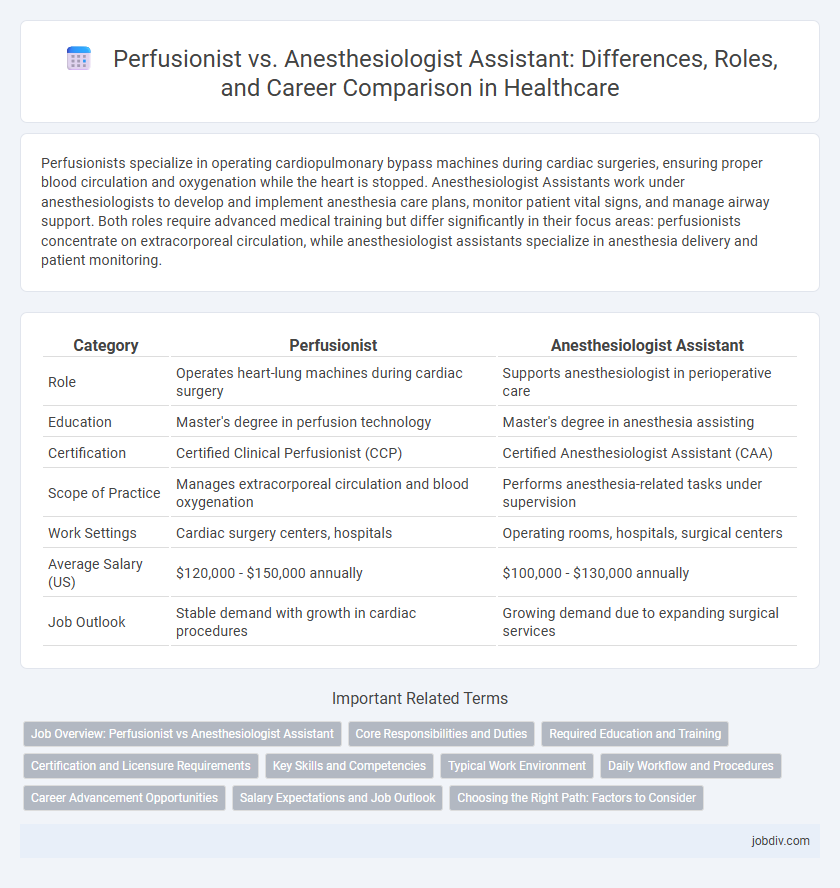Perfusionists specialize in operating cardiopulmonary bypass machines during cardiac surgeries, ensuring proper blood circulation and oxygenation while the heart is stopped. Anesthesiologist Assistants work under anesthesiologists to develop and implement anesthesia care plans, monitor patient vital signs, and manage airway support. Both roles require advanced medical training but differ significantly in their focus areas: perfusionists concentrate on extracorporeal circulation, while anesthesiologist assistants specialize in anesthesia delivery and patient monitoring.
Table of Comparison
| Category | Perfusionist | Anesthesiologist Assistant |
|---|---|---|
| Role | Operates heart-lung machines during cardiac surgery | Supports anesthesiologist in perioperative care |
| Education | Master's degree in perfusion technology | Master's degree in anesthesia assisting |
| Certification | Certified Clinical Perfusionist (CCP) | Certified Anesthesiologist Assistant (CAA) |
| Scope of Practice | Manages extracorporeal circulation and blood oxygenation | Performs anesthesia-related tasks under supervision |
| Work Settings | Cardiac surgery centers, hospitals | Operating rooms, hospitals, surgical centers |
| Average Salary (US) | $120,000 - $150,000 annually | $100,000 - $130,000 annually |
| Job Outlook | Stable demand with growth in cardiac procedures | Growing demand due to expanding surgical services |
Job Overview: Perfusionist vs Anesthesiologist Assistant
Perfusionists specialize in operating heart-lung machines during cardiac surgeries, ensuring proper oxygenation and blood flow, while Anesthesiologist Assistants collaborate directly with anesthesiologists to develop and implement anesthesia care plans. Both roles demand extensive knowledge of human physiology and advanced clinical skills but differ in their focus: perfusionists manage extracorporeal circulation, whereas anesthesiologist assistants focus on anesthesia administration and patient monitoring. Certification requirements include specific accredited programs and passing national certification exams tailored to each profession.
Core Responsibilities and Duties
Perfusionists specialize in operating heart-lung machines and managing extracorporeal circulation during cardiac surgeries, ensuring patient stability by regulating blood flow and oxygenation. Anesthesiologist Assistants focus on administering anesthesia, monitoring patient vitals, and assisting anesthesiologists throughout surgical procedures to maintain optimal sedation and pain control. Both roles require in-depth knowledge of physiology and pharmacology but differ primarily in procedural focus and scope within the surgical team.
Required Education and Training
Perfusionists must complete a specialized perfusion education program typically lasting 2 to 3 years, followed by certification from the American Board of Cardiovascular Perfusion (ABCP). Anesthesiologist Assistants are required to earn a master's degree from an accredited anesthesiologist assistant program, which generally takes 24 to 28 months, and pass the National Commission for Certification of Anesthesiologist Assistants (NCCAA) exam. Both professions demand rigorous clinical training but Perfusionists focus on cardiopulmonary bypass and extracorporeal circulation, while Anesthesiologist Assistants assist with anesthesia management under physician supervision.
Certification and Licensure Requirements
Perfusionists must obtain certification through the American Board of Cardiovascular Perfusion (ABCP), requiring completion of an accredited perfusion education program and passing a comprehensive exam, with ongoing continuing education for licensure renewal. Anesthesiologist Assistants are required to graduate from a master's level anesthesiologist assistant program accredited by the Commission on Accreditation of Allied Health Education Programs (CAAHEP) and must pass the certifying exam administered by the National Commission for Certification of Anesthesiologist Assistants (NCCAA), maintaining certification through periodic recertification and clinical practice. Both professions operate under state-specific licensing regulations that govern clinical practice standards and continuing education compliance.
Key Skills and Competencies
Perfusionists specialize in operating heart-lung machines during cardiac surgeries, requiring deep knowledge of cardiovascular physiology, blood chemistry, and advanced machinery management. Anesthesiologist Assistants focus on administering anesthesia and monitoring patients perioperatively, demanding expertise in pharmacology, airway management, and patient monitoring technologies. Both roles require strong critical thinking, teamwork, and crisis management skills essential for patient safety in surgical settings.
Typical Work Environment
Perfusionists typically work in hospital cardiac surgery suites, collaborating closely with surgeons and anesthesiologists to operate heart-lung machines during open-heart procedures. Anesthesiologist assistants are commonly found in operating rooms, preoperative assessment areas, and recovery units, supporting anesthesiologists in administering anesthesia and managing patient vitals. Both professions require a sterile, fast-paced clinical environment demanding acute attention to patient safety and teamwork.
Daily Workflow and Procedures
Perfusionists primarily operate heart-lung machines during cardiovascular surgeries, managing blood circulation and oxygenation to maintain patient stability. Anesthesiologist Assistants support anesthesiologists by monitoring vital signs, administering anesthesia, and adjusting dosages throughout surgical procedures. Both roles require close collaboration with surgical teams but differ in daily tasks, with perfusionists focusing on extracorporeal circulation technologies and anesthesiologist assistants concentrating on perioperative anesthesia care.
Career Advancement Opportunities
Perfusionists have specialized expertise in operating heart-lung machines during cardiac surgeries, leading to career advancement opportunities in cardiovascular perfusion management and research. Anesthesiologist assistants support anesthesia delivery and patient monitoring, with pathways to leadership roles in perioperative services and healthcare administration. Both professions offer potential for advanced certifications and involvement in clinical education to enhance career growth.
Salary Expectations and Job Outlook
Perfusionists typically earn an average annual salary ranging from $120,000 to $150,000, driven by their specialized role in operating heart-lung machines during cardiac surgeries. Anesthesiologist Assistants earn slightly less, with average salaries between $100,000 and $130,000, reflecting their collaborative role in anesthesia management under anesthesiologists' supervision. Employment growth for both professions is projected to rise by about 12% over the next decade, fueled by increasing demand for surgical procedures and cardiovascular care.
Choosing the Right Path: Factors to Consider
Choosing between a Perfusionist and an Anesthesiologist Assistant requires evaluating factors like educational requirements, job responsibilities, and work environment. Perfusionists specialize in operating heart-lung machines during cardiac surgeries, demanding specific technical training, whereas Anesthesiologist Assistants focus on anesthesia care under physician supervision, requiring a medical science background and strong patient management skills. Salary expectations, job growth projections from the Bureau of Labor Statistics, and personal interests in cardiovascular technology versus anesthesia support are crucial in making the right career decision.
Perfusionist vs Anesthesiologist Assistant Infographic

 jobdiv.com
jobdiv.com